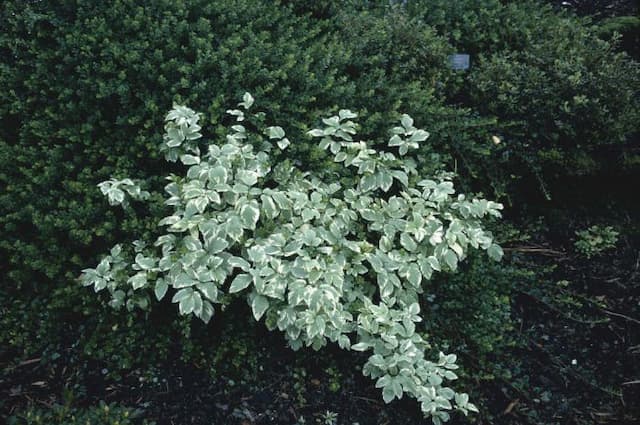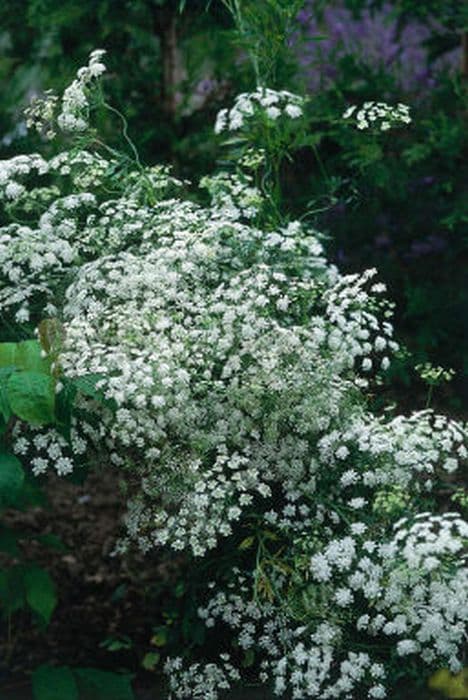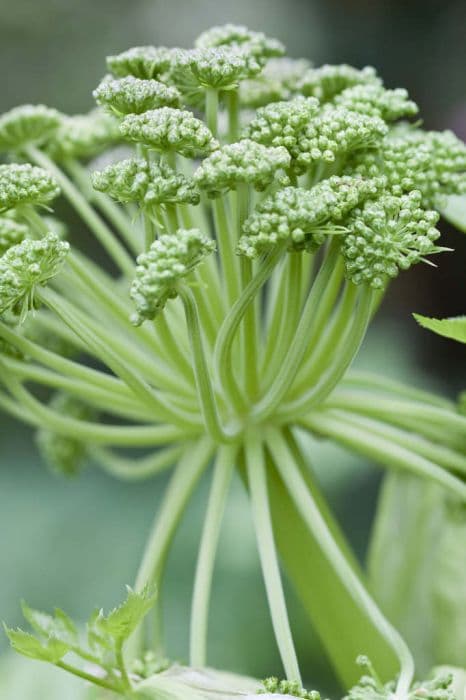Great Masterwort Astrantia 'Star of Treasure' (PBR)

ABOUT
Astrantia 'Star of Treasure' is a captivating plant known for its unique and ornate flowers. The blossoms are a distinguishing feature, showcasing a pincushion-like center made up of tiny, packed florets which may be glimpsed peeking through a starry bract cloak. These bracts are not true petals but rather modified leaves that appear petal-like, often radiating outward from the central cluster in a striking star-shaped pattern. They are usually a shade contrasting with the central florets, adding depth and complexity to the flower's appearance. The foliage of Astrantia 'Star of Treasure' is also attractive, with deeply lobed and palmate leaves that present a lush backdrop for the intricate flowers. The leaves are usually a vibrant green hue, contributing to the plant's overall aesthetic appeal throughout its growing season. This particular variety may also bear stems that are tinged with color, adding another layer to the visual interest of the plant. The plant's general shape and structure create an aesthetic of subtle elegance, combining the striking features of both flowers and foliage into a harmonious display often sought after for garden designs and floral arrangements.
About this plant
 Names
NamesFamily
Apiaceae
Synonyms
Great Masterwort, Hattie's Pincushion, Melancholy Gentleman, Masterwort
Common names
Astrantia 'Star of Treasure' (PBR)
 Toxicity
ToxicityTo humans
Masterwort is not commonly known to be toxic to humans. However, as with any plant, individual sensitivities can cause mild reactions in some people. It is always advisable to avoid ingesting plants that are not known to be edible and to seek medical advice if any adverse reactions occur after handling or accidental ingestion.
To pets
Masterwort is not commonly known to be toxic to pets. However, as with humans, individual animals may have different sensitivities, and it is always best to prevent pets from ingesting plants not intended for consumption. If you suspect your pet has eaten a significant amount of Masterwort and is showing signs of distress, consult a veterinarian as a precaution.
 Characteristics
CharacteristicsLife cycle
Perennials
Foliage type
Deciduous
Color of leaves
Green
Flower color
Pink
Height
2 feet (60 cm)
Spread
2 feet (60 cm)
Plant type
Herb
Hardiness zones
5
Native area
Europe
Benefits
 General Benefits
General Benefits- Attractive Flowers: The Astrantia 'Star of Treasure' produces beautiful pincushion-like flowers that are ideal for adding visual interest to any garden.
- Long Blooming Season: This variety often has a long flowering period, providing colour and texture from early summer into autumn.
- Pollinator Friendly: The flowers attract a wide range of pollinators including bees and butterflies, supporting biodiversity.
- Low Maintenance: Astrantia is known for being easy to care for, requiring minimal upkeep once established.
- Drought Tolerance: Once established, it can tolerate periods of drought, making it suitable for gardens with less water availability.
- Shade Tolerance: It can grow in partial shade, offering flexibility in garden design and plant placement.
- Deer and Rabbit Resistant: The plant is not typically favored by deer or rabbits, reducing the risk of damage from wildlife.
- Cut Flowers: The blooms make excellent cut flowers for indoor arrangements, having good vase life and unique appearance.
- Border Planting: Its mounding habit and attractive foliage make it ideal for borders and edging in a landscape design.
- Winter Interest: The seed heads can remain attractive in winter, providing visual interest even in the colder months.
 Medical Properties
Medical PropertiesThis plant is not used for medical purposes.
 Air-purifying Qualities
Air-purifying QualitiesThis plant is not specifically known for air purifying qualities.
 Other Uses
Other Uses- Pressed Flower Art: The unique blossoms of Astrantia can be pressed and used to create detailed, delicate artwork that preserves the beauty of the plant in a two-dimensional form.
- Fragrance Extraction: While not typical, the subtle scent of Astrantia flowers could be extracted and used in making boutique perfumes or scented candles.
- Natural Dyes: The pigments in Astrantia flowers could be used to produce natural dyes for textiles or art projects, offering a range of soft, muted colors.
- Photography Subject: Astrantia makes a photogenic subject for macro photography due to its intricate floral patterns, which are appealing for photo books and nature portfolios.
- Fairy Gardens: Because of their delicate and starry appearance, Astrantia flowers can be incorporated into fairy garden designs to add a magical touch to miniature landscapes.
- Edible Flower Garnishes: Although not commonly consumed, the blooms of Astrantia could be used as edible garnishes on desserts or salads after proper verification of non-toxicity.
- Floral Crafts: Astrantia can be used in floral crafts, such as making flower crowns or decorating wreaths, due to their long-lasting and visually pleasing blossoms.
- Teaching Tool: The intricate structure of Astrantia blooms can be used as a teaching tool in botany classes to illustrate the complexity of flower forms and pollination mechanisms.
- Culinary Experiments: Creative chefs might explore the use of Astrantia flowers as a unique ingredient in experimental or conceptual dishes, although it is not traditionally eaten.
- Seed Harvesting: As a patented variety, Astrantia 'Star of Treasure' seeds could be collected (with respect to propagation rights) and studied for genetic research or selective breeding practices.
Interesting Facts
 Feng Shui
Feng ShuiThe plant Astrantia is not used in Feng Shui practice.
 Zodiac Sign Compitability
Zodiac Sign CompitabilityThe plant Astrantia is not used in astrology practice.
 Plant Symbolism
Plant Symbolism- Perfection and Precision - The intricate star-shaped blossoms of the Astrantia 'Star of Treasure', which is commonly known as Masterwort, symbolize a sense of perfection and precision in nature's design.
- Protection - In traditional herbology, Masterwort was used to concoct remedies believed to protect against various ailments, thus symbolizing protection and healing.
- Secrets of the Stars - Its celestial name and shape associate Masterwort with mysticism and the unknown, symbolizing the secrets and wonders of the stars.
- Longevity - Masterwort is valued for its long-lasting flowers both in the garden and as cut flowers, symbolizing endurance and longevity.
- Mystery and Magic - The intricate patterns of Masterwort blooms are reminiscent of magic and mystery, which is often represented in its symbolic meanings.
- Harmony with Nature - Masterwort's ability to attract a variety of pollinators, such as bees and butterflies, symbolizes a deep connection and harmony with nature.
 Water
WaterGreat masterworts, such as Astrantia 'Star of Treasure', should be watered regularly to maintain consistently moist soil, especially during their growing season in spring and summer. It is recommended to water them once or twice a week depending on climate conditions and soil type. Deep watering is advisable, ensuring that the water penetrates several inches into the soil. Typically, using approximately one to two gallons per watering session should suffice, depending on the size of the plant and the weather. During hot, dry spells, watering frequency may increase, but always check the soil moisture before adding more water.
 Light
LightGreat masterwort thrives best in partial shade to full sun. It is optimal to plant it in a spot where it receives morning sunlight and is protected from the intense afternoon sun, which can be too harsh for the plant. Dappled sunlight under the canopy of open trees is also a fitting condition for growing Astrantia 'Star of Treasure'.
 Temperature
TemperatureThe great masterwort prefers temperate climates with temperatures ranging from 50°F to 75°F for optimal growth. It can tolerate temperatures as low as 20°F but sustained cold below this temperature can harm or kill the plant. During the peak of summer, if the temperature consistently rises above 80°F, it is important to provide some shade to prevent stress.
 Pruning
PruningPruning great masterwort is done to remove spent flowers and encourage reblooming, as well as to maintain plant shape and health. It should be pruned after the first flush of blooms in mid to late summer. Deadheading the old flower stems can stimulate another bloom cycle. In late autumn or early spring, cut back the old foliage to tidy up the plant and make way for new growth.
 Cleaning
CleaningAs needed
 Soil
SoilThe best soil mix for Masterwort (Astrantia 'Star of Treasure') should be rich, moist, and well-draining, with a mix of loamy soil, compost, and leaf mold or peat. It prefers neutral to slightly alkaline soil with a pH range of 6.5 to 7.5.
 Repotting
RepottingMasterwort (Astrantia 'Star of Treasure') typically does not require frequent repotting and can be repotted every 2-3 years to refresh the soil and manage its size.
 Humidity & Misting
Humidity & MistingMasterwort (Astrantia 'Star of Treasure') thrives in average garden humidity conditions and does not require specific humidity levels as long as the soil remains consistently moist.
 Suitable locations
Suitable locationsIndoor
Grow in bright, indirect light with moist soil.
Outdoor
Plant in partial shade with rich moist soil.
Hardiness zone
4-7 USDA
 Life cycle
Life cycleThe life cycle of Astrantia 'Star of Treasure', also known as Great Masterwort, begins with seed germination in early spring, typically after a period of cold stratification that simulates winter and breaks seed dormancy. Following germination, seedlings emerge and establish a rosette of leaves at the soil surface. As the season progresses, the plant develops a sturdy stem and foliage, and by early to mid-summer, it produces distinctive, pincushion-like flowers that attract pollinators. After pollination, flowers mature into seed heads, dispersing seeds in late summer to early fall. The plant can also propagate vegetatively through division in the spring or autumn, contributing to the spread and perpetuation of the plant. The perennial nature of Astrantia 'Star of Treasure' allows it to die back to the ground during winter and regrow the following spring, continuing its life cycle.
 Propogation
PropogationPropogation time
Spring-Early Summer
The most popular method of propagating Astrantia 'Star of Treasure', also commonly known as Great Masterwort, is through division. The optimal time for this is in early spring or fall when the plant is not in active growth. To propagate by division, carefully lift the entire plant from the ground with a spade. You should see natural divisions or clumps in the root system. Using your hands or a sharp knife, gently separate these clumps making sure that each division has a good amount of roots attached. Replant these divisions at the same soil depth they were originally growing at, spacing them about 18 inches (approx. 45 centimeters) apart to provide enough room for growth. Water the newly planted divisions thoroughly to help establish them.









